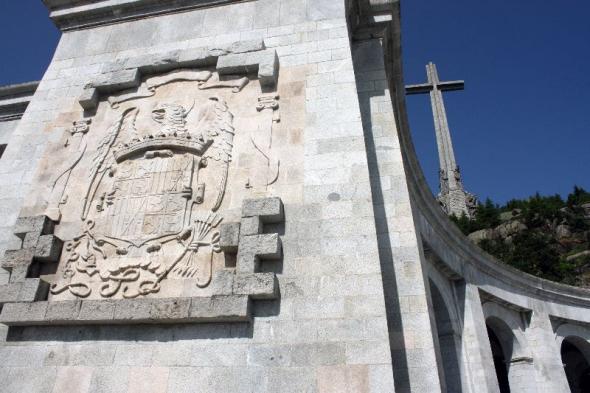The Valley of the Fallen in 21st century Spain
The Valley of the Fallen is the most controversial monument in contemporary Spain. It was first imagined by Francisco Franco during the Civil War (1936-1939) to host the bodies of the winners in the conflict and establish a permanent religious cult to commemorate their martyrdom and sacrifice. The project started to be built in 1940 and, after almost twenty years, was inaugurated by Franco on April 1 st 1959, the 20th anniversary of the “Victory”. It is a massive and most impressive compound whose basilica, carved in a hill, is topped by a 150-meter-high cross. Conceived of as a pantheon, since 1959 it started to receive Civil war bodies from all over the country, totalling an estimated 33.800 people buried in its subterranean crypts.
 Valley of the Fallen | anonymous photographer
Valley of the Fallen | anonymous photographer
Shortly before its inauguration, the leader of Spain’s fascist party (Falange), José Antonio Primo de Rivera, who was executed in November 20th 1936 by the Republican authorities, was moved there to a priority location placed before the main altar. When Franco died in November 20th 1975, the decision was taken by top officials in his government to move his body to the Valley. He was placed on the far side of the main altar, opposing Primo de Rivera. The coincidence of the date of their deaths made of 20N the most emblematic memorial landmark for Franco nostalgics. During decades, groups of Francoist supporters and Falange members staged celebratory rituals, including military parades from Madrid to the Valley, roman salutes and the singing of fascist anthems by the tombstones of Franco and José Antonio. Although this political cult slowly faded away, the 2007 Memory Law by socialist president Rodríguez Zapatero made it illegal to stage any political display in the monument. Yet in their outdated daily masses, Benedictines continue to this day to pray daily for the “unity of Spain,” and the blood shed by the martyrs in the Civil War. While Jose Antonio’s tomb has lost prominence with time, Franco’s grave – more specifically his bodily remains —have increasingly become the ultimate bastion of his regime’s outstretched and decaying sovereignty. In the midst of the contemporary memory struggles in Spain, propelled by the exhumation of Civil War mass graves containing the tens of thousands of bodies of civilians executed by Franco’s supporters that started in 2000, the Spanish socialist Government appointed a Commission of Experts in 2011 to provide recommendation for the transformation and democratization of the monument, whose current meaning and narrative continues to be Francoist. The most controversial proposal involved the necessary exhumation of Franco’s body before any major re-signification could take place. Another one was to, in spite of the technical difficulties, attend the claims of relatives of Republican executed civilians that were exhumed from mass graves and brought to the building without their permission or even knowledge, who reclaimed that these bodies were returned to them. In the period 2011-2018, Rajoy’s right-wing government stopped all funding for memory activities in the country and ignored the recommendations regarding the Valley of the Fallen – considered by the political right as a place of reconciliation between the “two Spains”— and the placement of Franco’s body. In June 2018, the newly appointed socialist president Pedro Sánchez announced as one of his star political commitments to exhume Franco from the Valley. In February 2019 he had to call for new elections without being able to keep his promise. After this direct threat to Franco’s privileged burial place, visits to the Valley by Francoist nostalgics have skyrocketed in the last few months. Resistance to Franco’s removal from the monument has come from many fronts. Most prominently, the family, the Francisco Franco Foundation, the Association for the Defense of the Valley and the very Benedictines who run the religious cult in the monument. The fact that Franco is buried in sacred land, the Basilica, and his family’s decision to bring the body to Madrid’s Cathedral if he is exhumed from the Valley, a measure they bluntly oppose, has prompted the Government to search unsuccessfully for complicity in the Vatican, scaling up the controversy to a diplomatic realm. The fate of Franco’s body, still today in the Valley, has transformed into a formidable political and memorial arena questioning the ability of Spain’s democracy to defeat once and for all the resilient ghost of its last dictator.
Recommended reading in Open Access: Francisco Ferrandiz. 2019. “Unburials, Generals and Phantom Militarism”. Current Anthropology 60, no. 19 (February 2019): 62-76.